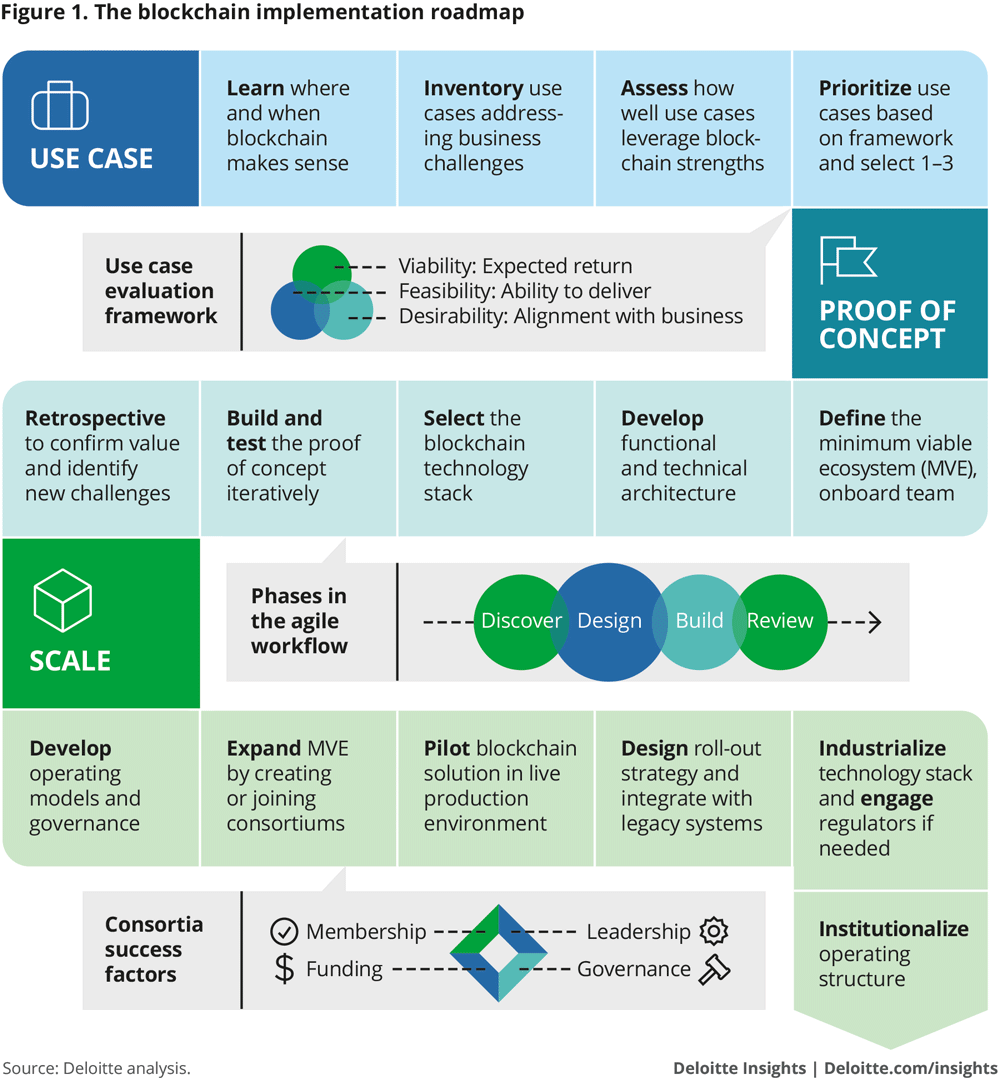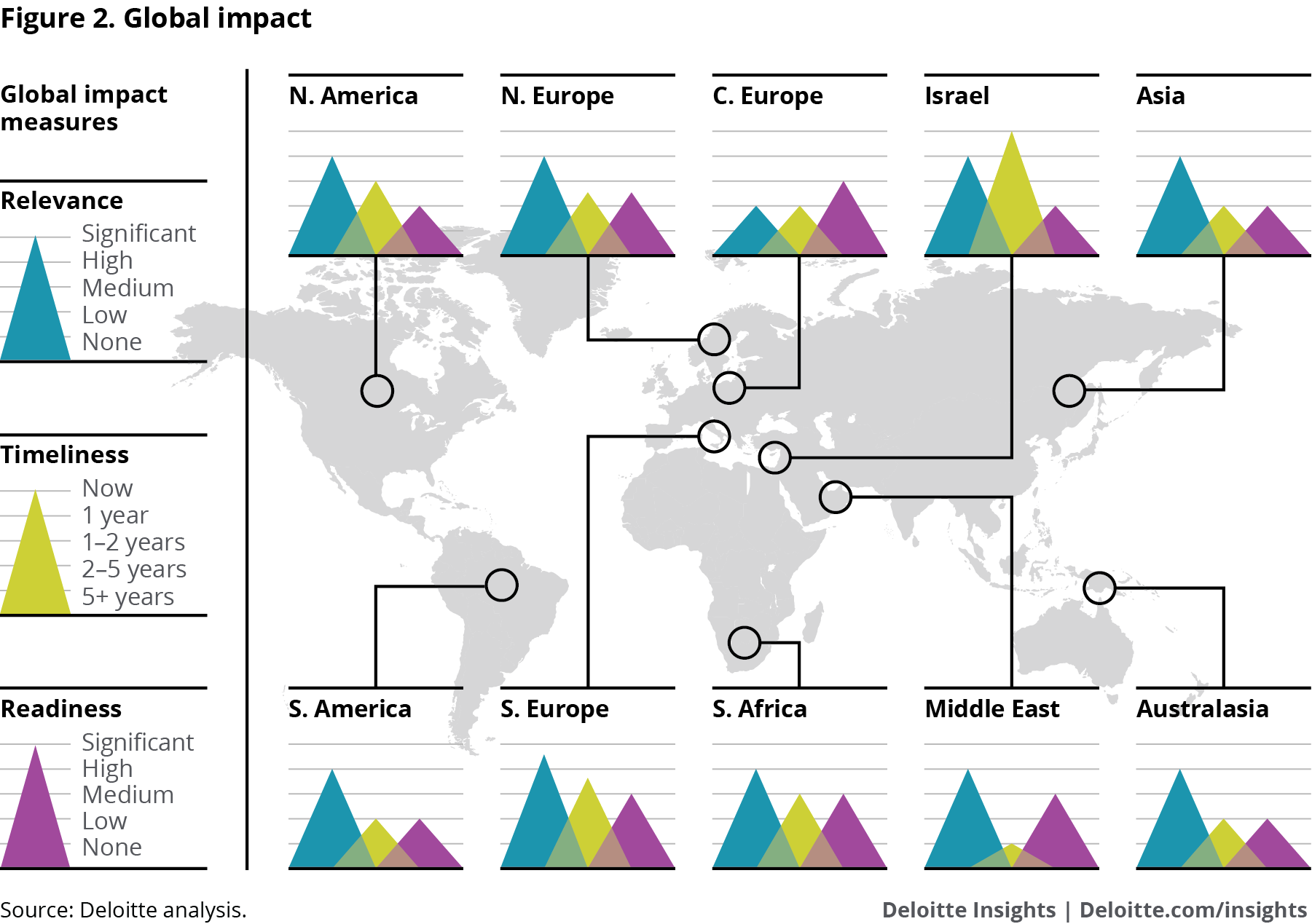Blockchain to blockchains: Broad adoption and integration enter the realm of the possible has been saved

Blockchain to blockchains: Broad adoption and integration enter the realm of the possible Tech Trends 2018
06 December 2017
Now that everyone is getting comfortable with blockchain platforms, what’s next? Companies should look to standardize the technology, talent, and platforms that will drive future initiatives—and, after that, look to coordinate and integrate multiple blockchains working together across a value chain.
Learn More
View Tech Trends 2018
Watch the video
Explore Deloitte's Technology Strategy & Transformation services
Create a custom PDF
Amid the media frenzy surrounding bitcoin a few years back, prescient technologists and business leaders recognized that the real story was not the scandals swirling around Silk Road or Mt. Gox but, rather, bitcoin’s technology endoskeleton, blockchain. They saw tremendous disruptive potential in this open, shared ledger platform. For example, public and private sector organizations might use it to share information selectively and securely with others, exchange assets, and proffer digital contracts.1 Individuals could use blockchain to manage their financial, medical, and legal records—a scenario in which blockchain might eventually replace banks, credit agencies, and other traditional intermediaries as the gatekeeper of trust and reputation.2
Though at the time few use cases for such opportunities were ready for prime time, the notion that blockchain had significant potential not just for business but in society as a whole began to gain traction. Today, blockchain is garnering headlines once again, this time for the vast ecosystem of cross-industry use cases emerging around it. Blockchain is now finding applications in every region and sector. For example:
- Europe’s largest shipping port, Rotterdam, has launched a research lab to explore the technology’s applications in logistics.3
- Utilities in North America and Europe are using blockchain to trade energy futures and manage billing at electric vehicle charging stations.4
- Blockchain is disrupting social media by giving users an opportunity to own and control their images and content.5
- Blockchain consortiums—including the Enterprise Ethereum Alliance, Hyperledger Project, R3, and B3i—are developing an array of enterprise blockchain solutions.
This list is growing steadily as adopters take use cases and PoCs closer to production and industry segments experiment with different approaches for increasing blockchain’s scalability and scope. Indeed, the path to broad blockchain adoption looks strikingly well paved. Gartner Inc. projects that blockchain’s business value-add will grow to $176 billion by 2025.6
Yet there are several issues that warrant attention. With the proliferation of platforms and protocols in the marketplace today, no single solution has emerged as the clear winner; consequently, no technical or process standards are yet in place. Likewise, operational siloes keep some companies from either developing clear business plans around blockchain or collaborating with ecosystem partners for mass adoption.
In the latest blockchain trend that will unfold over the next 18 to 24 months, expect to see more organizations push beyond these obstacles and turn initial use cases and PoCs into fully deployed production solutions. Though the tactics they use to achieve this goal may differ by sector and unique need, many will likely embrace three approaches that, together, comprise the latest blockchain trend:
- Focus blockchain development resources on use cases with a clear path to commercialization
- Push for standardization in technology, business processes, and talent skillsets
- Work to integrate and coordinate multiple blockchains within a value chain
Because we are only now coming to the end of a hot blockchain hype cycle, many people assume that enterprise blockchain adoption is further along than it actually is. In reality, it will take time and dedication to get to large-scale adoption. But when it does arrive, it will be anchored in the strategies, unique skillsets, and pioneering use cases currently emerging in areas such as trade, finance, cross-border payments, and reinsurance.
As these sectors lead in the coming months, blockchain’s future will follow.
Treading the path to commercialization
Regardless of industry bias, blockchain use cases that feature a clear path to commercialization often stand a better chance of reaching production. Why? Because in the minds of stakeholders and decision-makers, the words “potential ROI” can magically transform a nebulous tech concept into a scalable business opportunity.
By focusing available resources exclusively on those use cases and PoCs offering a path to commercialization, CIOs are offering clear incentives for stakeholders and partners, driving ROI in individual blockchain solutions, and potentially creating additional revenue or cost savings opportunities. In a way, they are also formalizing and legitimizing blockchain development strategies, both prerequisites for further refining project goals, setting timelines, and recruiting specialized talent.
By answering the following questions, CIOs can assess the commercial potential of their blockchain use cases:
- How does this use case enable our organization’s strategic objectives over the next five years?
- What does my implementation roadmap look like? Moreover, how can I design that roadmap to take use cases into full production and maximize their ROI?
- What specialized skillsets will I need to drive this commercialization strategy? Where can I find talent who can bring technical insight and commercialization experience to initiatives?
- Is IT prepared to work across the enterprise (and externally with consortium partners) to build PoCs that deliver business value?
One final point to keep in mind: Blockchain use cases do not necessarily need to be industry-specific or broadly scoped to have commercial potential. In the coming months, as the trend toward mass adoption progresses, expect to see more use cases emerge that focus on enterprise-specific applications that meet unique value chain issues across organizations. If these use cases offer potential revenue opportunities down the road—think licensing, for example—all the better.
Next stop, standardization
As blockchain use cases grow in scope, scale, and complexity, the need for standardized technologies, platforms, and skillsets becomes more pressing each day. Consider standardization’s potential benefits—none of which companies developing blockchain capabilities currently enjoy:
- Enterprises would be able to share blockchain solutions more easily, and collaborate on their ongoing development.
- Standardized technologies can evolve over time. The inefficiency of rip-and-replace with every iteration could become a thing of the past.
- Enterprises would be able to use accepted standards to validate their PoCs. Likewise, they could extend those standards across the organization as production blockchains scale.
- IT talent could develop deep knowledge in one or two prominent blockchain protocols rather than developing basic knowhow in multiple protocols or platforms.
Unfortunately, there are currently no overarching technical standards for blockchain, and it is unrealistic to think we will get them soon, if ever, across all use cases. For CIOs, this presents a pressing question: Do you want to wait for standards to be defined by your competitors, or should you and your team work to define the standards yourselves?
For financial services giant JP Morgan Chase, sitting on the sidelines while others in the financial sector developed blockchain standards was not an option. In 2017, the firm launched Quorum, an open-source, enterprise-ready distributed ledger and smart contracts platform created specifically to meet the needs of the financial services industry. Quorum’s unique design remains a work in progress: JP Morgan Chase invited technologists from around the world to collaborate to “advance the state of the art for distributed ledger technology.”7
Not all IT shops are in a position to emulate this strategy for influencing the development of blockchain standards. But there are steps that CIOs can take to promote standardization within their companies and industries rather than waiting passively for universal standards to emerge. For example, by plugging into external developer ecosystems, IT shops can begin influencing standardization discussions and exchanging best practices with like-minded organizations. Internally, CIOs can empower their teams to make decisions that drive standards within company ecosystems. Finally, in many organizations, data management and process standards already exist. Don’t look to reinvent the wheel. Apply these same standards to your blockchain solution.

Integrating multiple blockchains in a value chain
In the future, blockchain solutions from different companies or even industries will be able to communicate and share digital assets with each other seamlessly. For organizations whose use cases turn on blockchain ecosystem diversity and scalability, the potential benefits of integration are clear: Having more partnerships within a blockchain ecosystem can drive greater value and boost blockchain ROI. Likewise, interoperability can make it possible to customize and enhance blockchain solutions without rendering them obsolete.
Unfortunately, many of the technical challenges preventing blockchain integration persist. Different protocols—for example, Hyperledger Fabric and Ethereum—cannot integrate easily. Think of them as completely different enterprise systems. To share information between these two systems, you would need to create an integration layer (laborious and painful) or standardize on a single protocol.
Even if the technical challenges were solved, connecting two blockchains is much harder than connecting two networks. Why? Because with blockchain integration, you are connecting two value networks that may not necessarily talk to each other. This means that when transferring digital assets from one blockchain to another, you must be able to transfer the first blockchain’s value set of all its past transactions as well. You must also be able to guarantee that the data packets point to the same places in both blockchains, which helps maintain data integrity and auditability.
Right now, the Hyperledger Foundation and others are working to establish technical standards that define what constitutes a blockchain, and to develop the protocols required to exchange assets. These efforts will continue, and as they do, convergence of protocols will likely accelerate and standards emerge. Likewise, interoperable technologies will eventually mature, with new protocols that support communication between different technologies becoming broadly available. Until then, organizations can enjoy some integration benefits by working within a consortium model in which all participants deploy the same solutions and protocols. (When integration challenges are solved, those already sharing common processes and standards within a consortium may enjoy the competitive advantage of momentum.) There are also bridge technologies available that make it possible to move digital assets between blockchains. Think of the process like this: You move digital assets from point A to point B in a car. At point B, you transfer the assets from the car to a train, which takes it to its final destination at point C. It’s inelegant, but it can deliver the desired business outcome.
Lessons from the front lines
Linking the chains
In October 2016, global insurance and asset management firm Allianz teamed up with several other insurance and reinsurance organizations to explore opportunities for using blockchain to provide client services more efficiently, streamline reconciliations, and increase the auditability of transactions.8
“Blockchain is a new technology that is a bit mind-bending,” says Michael Eitelwein, head of group enterprise architecture at Allianz. “It only makes sense if it is a shared concept, which is the motivating factor for peers in our industry to try and understand this together.”
Over the course of the following year, the joint effort—the Blockchain Insurance Industry Initiative (B3i)—welcomed 23 new members from across the insurance sector and began market-testing a new blockchain reinsurance prototype.9 Test participants were granted access to a “sandbox” environment in which they could simulate creating and settling contracts. “We took a straightforward, iterative, R&D approach,” Eitelwein says. “Our goal was to gauge how useful this prototype is in transacting contracts, and to understand its strengths and limitations before taking it to the next level of development.”10
In addition to participating in B3i, Allianz is working internally to determine if the same basic mechanism can be deployed across its global operations to facilitate interaction among multiple entities—a possibility that, while promising, presents several technical challenges. For example, can a blockchain platform be embedded in the architecture of systems that already communicate with each other? How would policy administration system designs for blockchain differ from traditional designs? And is it even possible to scale existing prototypes sufficiently to meet global enterprise needs?
A broader opportunity looms large above Allianz’s blockchain initiatives as well as those underway in other industries: integrating and orchestrating multiple blockchains across a single value chain. Currently, multiple parties can transact digitally only when everyone adopts a single shared ledger technology and one set of standards within a consortium—a limitation that diminishes blockchain’s potential value across B2B and peer-to-peer transactions.
“Our view is that blockchain makes sense only if you have common standards for interacting digitally, like those developed for the Internet,” Eitelwein says. “This would be especially powerful in retail; you can’t have 50 different blockchains for 50 different customers—it would never pay off.” Eitelwein says that multi-chain integration is certainly a goal of blockchain exploration, but the concept remains “unknown territory.”
For now, the B3i use case is laying the groundwork for future collaboration and even standardization across the insurance sector. “If by working together we can eventually create common standards for blockchain processes, we will be able to remove a lot of inefficiency from digital business,” Eitelwein says. “This could provide tremendous benefits to our customers, and for the digital economy as a whole. This is what we are aiming for.”11
Blockchain beyond borders: The Hong Kong Monetary Authority
The Hong Kong Monetary Authority (HKMA) is the central banking authority responsible for maintaining the monetary and banking stability and international financial center status of Hong Kong. Given its scope of responsibilities in developing and operating the territory’s financial market infrastructure, it comes as no surprise that its leadership took an interest in exploring blockchain’s or distributed ledger technology’s (DLT) potential for a variety of financial applications and transactions. After researching the value proposition of the technology alongside the Hong Kong Applied Science and Technology Research Institute, the HKMA published a white paper in November 201612 that raised more than 20 governance, legal, regulatory, and operational concerns that the financial industry should address when implementing blockchain or DLT. Leaders then decided to develop a proof of concept (PoC) to test the value proposition as well as to address those concerns.
The proof of concept focused on trade finance for banks, buyers and sellers, and logistics companies. It leveraged DLT to create a platform for automating labor-intensive processes via smart contracts, reducing the risk of fraudulent trade and duplicate financing, and improving the transparency and productivity of the industry as a whole. DLT provided immutable data integrity, enhanced reliability with built-in disaster recovery mechanisms, enabled near-real-time updates of data across the nodes, and acted as a repository for transactional data.
The trade finance PoC ran on a private blockchain network for a 12-week period from December 2016 through March 2017, with five Hong Kong banks participating. In addition to trade finance, HKMA developed two other successful PoCs for mortgage applications and digital identification.
“When banks saw the prototypes, they were excited and keen to commercialize the PoC as quickly as possible,” says Shu-pui Li, HKMA executive director of financial infrastructure. “At the beginning of the PoC project, we all thought distributed ledger technology had potential, but we had a lot of questions about whether it would work in a commercial environment. The prototype’s success opens up many possibilities.”
With seven banks now participating in the trade finance blockchain, HKMA intends to launch a production pilot in the second half of 2018. It plans to have a full commercialized solution in production by 2019. Also, there are a number of other banks waiting in the queue to participate in this platform.
Building on the success of its proofs of concept, HKMA is exploring interconnectivity between blockchains with Singapore’s government and Monetary Authority of Singapore (MAS), which could be the foundation of an international blockchain ecosystem. HKMA announced its joint venture with Singapore in October 2017 and a formal cooperative agreement was signed in November between the HKMA and MAS. Both authorities plan to implement the cross-border infrastructure (i.e. Global Trade Connectivity Network) at around the same time that it launches its domestic platform. Then, if other countries want to participate in the network, they would plug their local platform into the integrated distributed ledger technology infrastructure.
Since HKMA doesn’t know how many countries might connect to the infrastructure or what technology they might use, Li says the authority is exploring how to address interoperability. “We don’t have a perfect solution to interoperability, but we have identified some considerations and have some suggestions. We intend to work through those issues over the next year. But so far, so good. It’s encouraging to see so many banks working together to reach a consensus. In addition, a common standard for digitization of the documentations and trades is a critical success factor for this infrastructure.”13
My take
Peter Miller, president and CEO
The Institutes
Over the last 108 years, The Institutes has supported the evolving professional development needs of the risk management and insurance community with educational, research, networking, and career resource solutions. Now, as the industry faces increasingly fast-moving, innovative, and data-driven challenges, insurers have varying levels of knowledge about the benefits of blockchain. The next step is for The Institutes to help educate them about and prepare them for this technology.
People are starting to understand blockchain’s broader applications and how it can link various parties; it’s a distributed ledger and therefore, by definition, requires cooperation by participants. Like any century-old organization, we’ve adapted to our industry’s changing needs and problems, and we see blockchain’s potential applications. For our industry, blockchain has the capacity to streamline payments, premiums, and claims; reduce fraud through a centralized record of claims; and improve acquisition of new policyholders by validating the accuracy of customer data.
We’ve formed The Institutes RiskBlock Alliance, the first nonprofit, enterprise-level blockchain consortium. It will bring together risk management and insurance industry experts and blockchain developers to research, develop, and test blockchain applications for industry-specific use cases. It is by design a platform that’s agnostic of specific underlying technologies, developed in concert with other groups involved in the insurance industry—from life to property and casualty, including our membership, issuers, reinsurers, brokers, and others. Rather than focusing on single blockchain use cases, we believe in the need to communicate to multiple blockchains and enable federated inter-blockchain communication to facilitate reuse of capabilities among 30 organizations from various industry segments.
To start, we are tackling four use cases that technology has struggled to tame: proof of insurance, first notice of loss, subrogation, and parametric insurance. These cases all include multiple parties working together, using shared data and predefined contracts. They are ideal use cases because we can solve a business problem while demonstrating the capabilities of blockchain technology, which in turn will educate the industry on its potential. And while we’re excited about these initial focus areas, there are literally hundreds of equally compelling examples waiting to be explored.
A big challenge to interoperability is getting organizations to work together. We want to enable secure blockchain interconnectivity across the industry, and we are developing a framework that would support this. Since all organizations are under constraints to optimize cost structure, we are looking at an API layer to enable shared data and operations. We envision the consortium controlling the end products, with the integration into back-end legacy systems depending on each vendor.
To facilitate adoption, organizations need to advance along the learning curve and focus on the business problems that blockchain could solve. Finding great partners is essential, as is understanding why confidence in the technology is justified: Blockchain is building on a package of proven technologies—including distributed computing, cryptographic encryption, and hashing—and concerns about its capabilities shouldn’t hold back potential agreements for its use, whether in insurance or other industries.
Risk implications
Risk practitioners across industries are excited about blockchain’s potential to help organizations manage risks posed by current systems. However, organizations should understand that while blockchain may drive efficiency in business processes and mitigate certain existing risks, it poses new risks broadly classified under three categories: common risks, value transfer risks, and smart contract risks.14
Common risks
Blockchain technology exposes institutions to similar risks associated with current business processes—such as strategic, regulatory, and supplier risks—but introduces nuances for which entities need to account. Organizations that adopt blockchain should evaluate both the participating entities and the underlying platform; the choice of the latter could pose limitations on the services or products delivered, both now and in the future. From an infrastructure perspective, blockchain technology is part of the enterprise’s core, so it should integrate seamlessly with back-end legacy systems. Additionally, firms may be exposed to third-party risks, as some of the technology might be sourced from external vendors. For example, the typical risks of cloud implementation apply here for cases in which cloud-based infrastructure is part of the underlying technology for blockchain.
Value transfer risks
Because blockchain enables peer-to-peer transfer of value, the interacting parties should protect themselves against risks previously managed by central intermediaries. In the case of a blockchain framework, evaluate the choice of the protocol used to achieve consensus among participant nodes in the context of the framework, the use case, and network participant requirements. While the consensus protocol immutably seals a blockchain ledger, and no corruption of past transactions is possible, it remains susceptible to private key theft and the takeover of assets associated with public addresses. For example, if there is fraud on the value-transfer network, and a malicious actor takes over a noncompliant entity, then that actor can transfer and siphon value off of the network.
Smart contract risks
Smart contracts can encode complex business, financial, and legal arrangements on the blockchain, so there is risk associated with the one-to-one mapping of these arrangements from the physical to the digital framework. Additionally, cyber risks increase as smart contracts rely on “oracles” (data from outside entities) to trigger contract execution. Smart contracts apply consistently to all participant nodes across the network; they should be capable of exception handling that adheres to business and legal arrangements and complies with regulations. Like other software code, smart contracts require robust testing and adequate controls to mitigate potential risks to blockchain-based business processes. For example, smart contracts allow for straight-through processing (contractual clauses may be made partially or fully self-executing, self-enforcing, or both) as they directly interact with other smart contracts. One corrupted smart contract could cause a chain reaction that paralyzes the network.
The successful adoption of any new technology is dependent on the appropriate management of the associated risks. This is especially true when that technology is part of the organization’s core infrastructure, as is the case with blockchain. Additionally, it’s important to understand the evolution of regulatory guidance and its implications. For example, the Financial Industry Regulatory Authority has shared operational and regulatory considerations for developing use cases within capital markets.15 Organizations should work to address these regulatory requirements in their blockchain-based business models and establish a robust risk-management strategy, governance, and controls framework.
Global impact
Blockchain technology and its derivatives are continuing to mature, but a number of enabling conditions need to be addressed for its mainstream potential to be realized around the world. Deloitte leaders across 10 global regions see varying levels of certainty around the anticipated impact that the technology could have on financial services, manufacturing, supply chain, government, and other applications. While there are pockets of innovation in places such as Asia Pacific, Northern Europe, and Africa, many countries in Europe and Latin America are taking it slow, awaiting more standardization and regulation.
The general expected time frame for adoption is two to five years, with some notable exceptions. Most regions have seen an uptick in proof-of-concept and pilot activity, mostly by financial institutions working with blockchain start-ups. A few countries in Africa and Northern Europe are exploring national digital currencies and blockchain-based online payment platforms. In Asia Pacific, several countries are setting up blockchains to facilitate cross-border payments.
The Middle East, while bullish on blockchain’s potential—Dubai has announced its intention to be the first blockchain-powered government by 2020, for example16—finds itself in the very early phases of adoption; widespread adoption is expected to take up to five years in the region.
In most regions, the main barrier to adoption is public skepticism as well as concerns about regulation. However, as consortiums, governments, and organizations continue to develop use cases for smart contracts, and the public becomes more educated on potential benefits, viable blockchain applications should continue to evolve around the world.

Where do you start?
Though some pioneering organizations may be preparing to take their blockchain use cases and PoCs into production, no doubt many are less far down the adoption path. To begin exploring blockchain’s commercialization potential in your organization, consider taking the following foundational steps:
- Determine if your company actually needs what blockchain offers. There is a common misconception in the marketplace that blockchain can solve any number of organizational challenges. In reality, it can be a powerful tool for only certain use cases. As you chart a path toward commercialization, it’s important to understand the extent to which blockchain can support your strategic goals and drive real value.
- Put your money on a winning horse. Examine the blockchain uses cases you currently have in development. Chances are there are one or two designed to satisfy your curiosity and sense of adventure. Deep-six those. On the path to blockchain commercialization, focusing on use cases that have disruptive potential or those aligned tightly with strategic objectives can help build support among stakeholders and partners and demonstrate real commercialization potential.
- Identify your minimum viable ecosystem. Who are the market players and business partners you need to make your commercialization strategy work? Some will be essential to the product development life cycle; others will play critical roles in the transition from experimentation to commercialization. Together, these individuals comprise your minimum viable ecosystem.
- Become a stickler for consortium rules. Blockchain ecosystems typically involve multiple parties in an industry working together in a consortium to support and leverage a blockchain platform. To work effectively, consortia need all participants to have clearly defined roles and responsibilities. Without detailed operating and governance models that address liability, participant responsibilities, and the process for joining and leaving the consortium, it can become more difficult—if not impossible—to make subsequent group decisions about technology, strategy, and ongoing operations.
- Start thinking about talent—now. To maximize returns on blockchain investments, organizations will likely need qualified, experienced IT talent who can manage blockchain functionality, implement updates, and support participants. Yet as interest in blockchain grows, organizations looking to implement blockchain solutions may find it increasingly challenging to recruit qualified IT professionals. In this tight labor market, some CIOs are relying on technology partners and third-party vendors that have a working knowledge of their clients’ internal ecosystems to manage blockchain platforms. While external support may help meet immediate talent needs and contribute to long-term blockchain success, internal blockchain talent—individuals who accrue valuable system knowledge over time and remain with an organization after external talent has moved on to the next project—can be critical for maintaining continuity and sustainability. CIOs should consider training and developing internal talent while, at the same time, leveraging external talent on an as-needed basis.
© 2021. See Terms of Use for more information.







